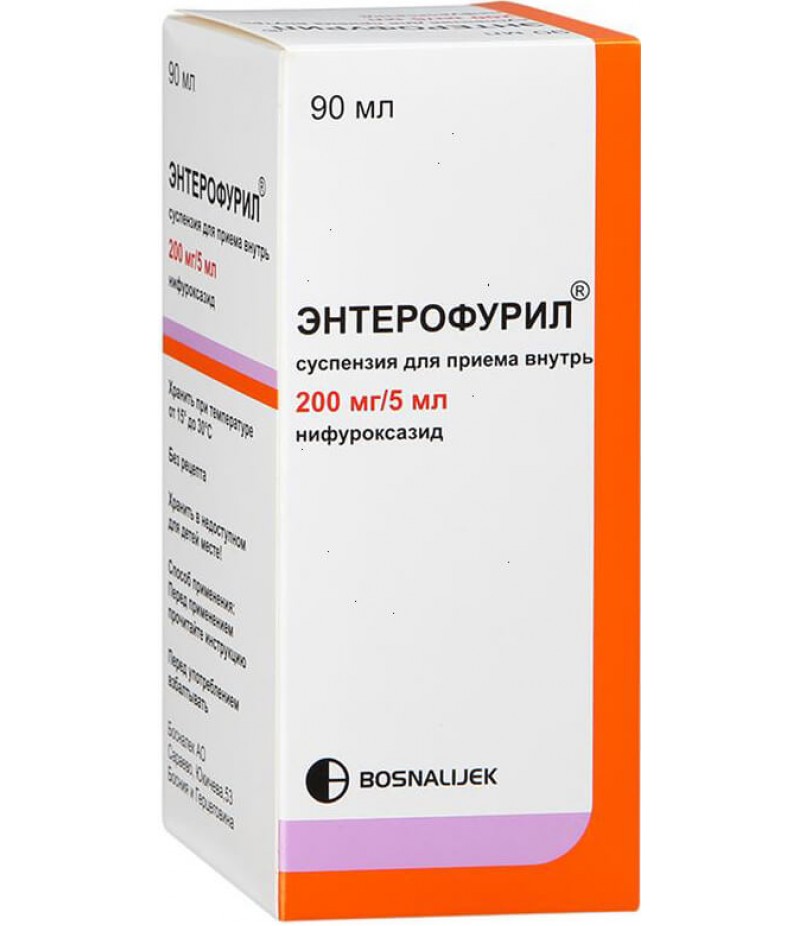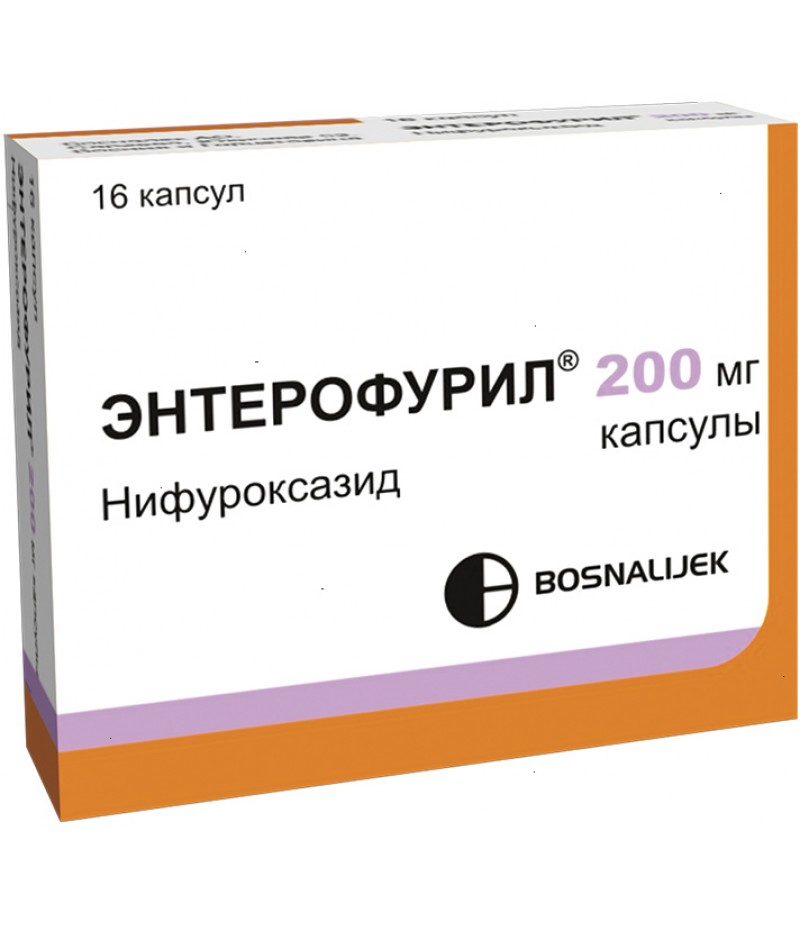Enterofuryl suspension 200mg/5ml 90ml
- $20.58
- 3 or more $20.30
- Availability:In Stock
Instruction for Enterofuryl suspensionYou can buy Enterofuryl suspension hereForm of release, composition and packagingSuspension for ingestion of yellow color, with the smell of a banana.5 mlnifuroxazide 200 mgAuxiliary substance..
Instruction for Enterofuryl suspension
You can buy Enterofuryl suspension here
Form of release, composition and packaging
Suspension for ingestion of yellow color, with the smell of a banana.
5 ml
nifuroxazide 200 mg
Auxiliary substances: sucrose - 1000 mg, sodium hydroxide - 2 mg, methylparahydroxybenzoate - 5 mg, ethanol 96% - 0.05 ml, carbomer - 10.5 mg, citric acid - 0.75 mg, banana flavor - 10 mg, water - up to 5 ml.
90 ml - bottles of dark glass (1) complete with a measuring spoon - packs cardboard.
pharmachologic effect of Enterofuryl suspension
A broad-spectrum antimicrobial agent, a derivative of 5-nitrofuran. It blocks the activity of dehydrogenases and depresses the respiratory chains, the cycle of tricarboxylic acids and a number of other biochemical processes in the microbial cell. Destroys the membrane of a microbial cell, reduces the production of toxins by microorganisms. Highly active against Campylobacter jejuni, Escherichia coli, Salmonella spp., Clostridium perfringens, Vibrio cholerae, pathogenic Vibrions and Vibrio parahaemolyticus, Staphylococcus spp. Weakly sensitive to nifuroxazide: Klebsiella spp., Proteus mirabilis, Providencia indologenes. Resistant to nifuroxazide: Klebsiella spp., Proteus mirabilis, Providencia spp., Pdeudomonas spp.
Does not disturb the balance of the intestinal microflora.
With acute bacterial diarrhea, eubiosis of the intestine is restored. When infected with enterotrophic viruses prevents the development of bacterial superinfection.
Pharmacokinetics
After oral administration, nifuroxazide is practically not absorbed from the digestive tract and manifests its antibacterial effect exclusively in the lumen of the intestine. Nifuroxazide is excreted by the intestine.
Indications
- acute bacterial diarrhea, which occurs without deterioration of the general condition, fever, intoxication.
Contraindications
- Hypersensitivity to the components of Enterofuryl suspension or other derivatives of nitrofuran;
- intolerance to fructose;
- glucose-galactose malabsorption syndrome or insufficiency of sucrose and isomaltase;
- Pregnancy;
- age up to 1 month, premature neonates (suspension for oral administration);
- Children under 3 years (capsules).
Dosage
Is taken internally.
Suspension for oral administration
For dosing, a 5 ml measuring spoon with a calibration of 2.5 ml is used.
Before use, the suspension should be well shaken.
Children aged 1 to 6 months: 2.5 ml of suspension 2-3 times / day at intervals of 8 to 12 hours.
Children from 7 months to 3 years: 2.5 ml of suspension 3 times / day with an interval of 8 hours.
Children aged 3 to 6 years: 5 ml of suspension 3 times / day with an interval of 8 hours.
Children aged 6 to 18 years: 5 ml of suspension 3-4 times a day at intervals of 6 to 8 hours.
Adults: 5 ml of suspension 4 times / day with an interval of 6 hours.
The duration of the course of treatment is 5-7 days, but not more than 7 days. If no improvement occurs within the first 3 days of admission, you should see a doctor.
Side effects
Allergic reactions: rash, hives, Quincke's edema, anaphylactic shock.
Overdose
Symptoms of overdose are unknown. Treatment is symptomatic.
Drug Interactions
It is not recommended simultaneous use with drugs that cause the development of disulfiram-like reactions, drugs that depress the function of the nervous system. If you are taking other medications (including OTC drugs), consult your doctor before using the drug.
special instructions
In the treatment of diarrhea concomitantly with therapy with Enterofuryl, rehydration therapy is necessary. In the case of bacterial diarrhea with signs of systemic damage, you should consult a doctor to decide on the use of antibacterial drugs of systemic action.
If symptoms of hypersensitivity (dyspnea, rash, itching) appear, stop taking the drug. The use of alcohol during therapy with nifuroxazide is prohibited.
In connection with the content of methyl parahydroxybenzoate, Enterofuryl suspension may cause allergic reactions (possibly delayed).
Enterofuryl suspension contains 1000 mg of sucrose in 5 ml. Accordingly, the content of sucrose in a single dose of 2.5 ml suspension is 0.04165 XE, and in a single dose of 5 ml - 0.0833 XE.
The daily dose of sucrose is 0.0833 XE when taking 2.5 ml of suspension 2 times a day and 0.125 XE with 2.5 ml of suspension 3 times a day.
The ethanol content of the Enterofuryl suspension is 1%. The minimum single dose of the drug corresponding to 100 mg of nifuroxazide (2.5 ml of suspension) contains 0.02 g of ethanol (in terms of absolute alcohol) and the maximum daily dose corresponding to 800 mg of nifuroxazide (5 ml of suspension 4 times daily) contains 0.16 g of ethanol (in terms of absolute alcohol).
Before the appointment of Enterofuryl suspension, the congenital deficiency of enzymes that break down sucrose should be excluded from patients (including infants).
Impact on the ability to drive vehicles and manage mechanisms
The drug does not affect psychomotor activity and the ability to drive vehicles and work with mechanisms.
Pregnancy and lactemia
In studies on animals, there was no teratogenic effect. However, as a precaution, taking nifuroxazide during pregnancy is not recommended.
During the lactation period, it is possible to continue breastfeeding in the case of a short course of treatment with Enterofuryl suspension, it is necessary to consult a doctor.
Application in childhood
Prescribe the drug to children older than 1 month.
Contraindicated at the age of up to 1 month and in premature newborns.
Conditions of leave from pharmacies
To buy Enterofuryl suspension the prescription is not required.
Terms and conditions of storage
The drug in the form of a suspension for oral administration should be stored at a temperature of 15 ° to 30 ° C. Shelf life - 3 years. The vial should not be stored for more than 14 days.
The drug should be stored out of the reach of children.


